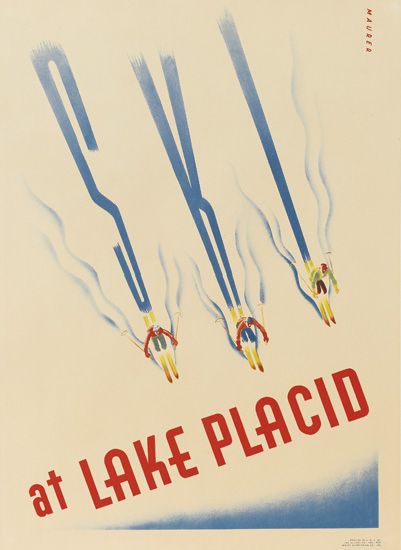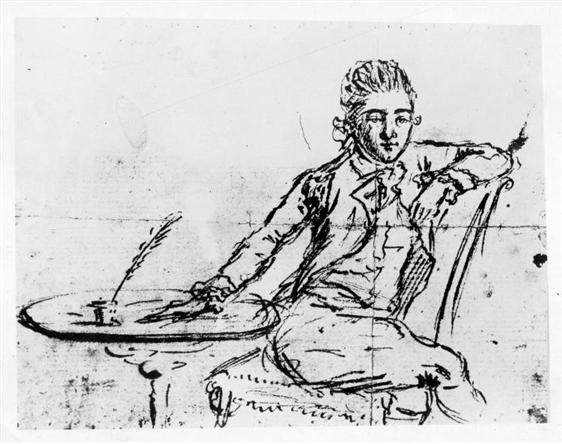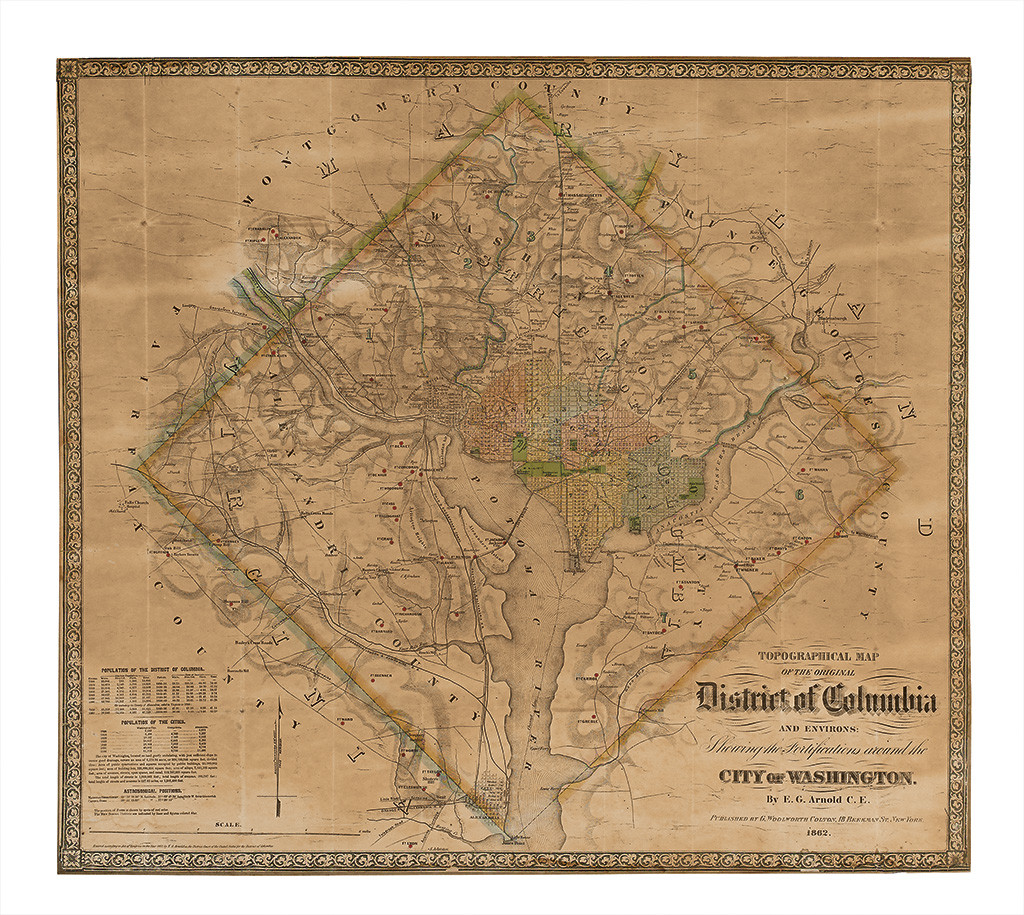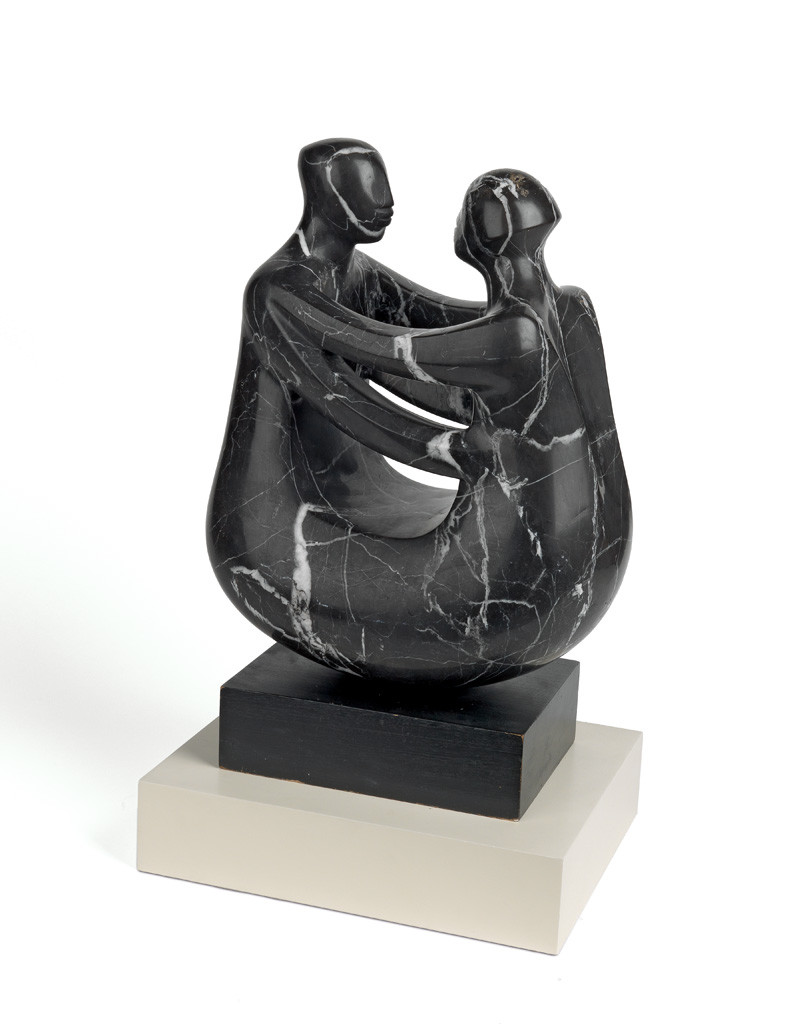Remembering Eldzier Cortor
Records & Results: Old Master Through Modern Prints
View full results here.
Records & Results: 19th & 20th Century Literature Featuring The Lawrence M. Solomon Collection
Right, Lot 284: Mary Roberts Rinehart, The Man in the Lower Ten, first edition, in dust jacket, Indianapolis, (1909). Sold November 10, 2015 for $5,500.
View the full results here.
The Foundation of a Capital: Early Maps of Washington D.C.
The city was officially founded on July 16, 1790. The Congress of the Confederation had been temporarily located in New York City after being rousted from Philadelphia by the Pennsylvania Mutiny of 1783, during which a group of soldiers demanded payment for their service in the Revolutionary War. After several relocations, the United States Congress was officially formed in 1789, and set about establishing a home for the government. The Residence Act established the capital on the banks of the Potomac, decreeing that the District should encompass no more than 10 square miles on each side.
Notes from the Catalogue: Elizabeth Catlett's Varied Mediums
Melanie Herzog, Art Historian and author of several books on Catlett, illustrates three oils, Pensive Portrait, 1945, Woman, circa 1945, and Trash, oil on canvas, 1946, and describes two other paintings, Protection and Margaret and Gayle that are now presumably lost. Herzog additionally lists Black Worker, 1946, and Woman Playing Guitar, 1947, that were shown with the three illustrated works in Catlett's exhibition at the Caribbean Cultural Center in 1996. In 2011, Sharecropper, oil on canvas, 1946 was exhibited at the Studio Museum in Harlem. Other known paintings date from her association with the Barnett-Aden Gallery, Washington, DC, and are found today in the Barnett-Aden Collection and the Margaret and John Gottwald Collection, Richmond, VA. Their 2012 exhibition at the Virginia Museum of Fine Art, "Making History: 20th Century African-American Art," included a tempera painting Hats by Suzy White, circa 1937, and an oil on canvas portrait, Untitled, 1947.
Friends is a wonderful example of Catlett's work from the period, and displays the different influences on American art in the 1940s. The painting's social realism is seen in the intimate view of a couple, and the attention to the fine details of their working clothes. It also shows Catlett's growing interest in abstraction with the developed sculptural qualities of their faces.
In the early 1940s, Elizabeth Catlett lived in New York between her time in Chicago and teaching at Dillard University. Elizabeth Catlett and her husband Charles White returned to New York in 1943 after he finished a year at Hampton University painting his mural Contribution of the American Negro to Democracy with a Julius Rosenwald grant. Herzog describes how Catlett's teaching at the George Washington Carver School gave her little time to her own artwork but she continued to paint. Teaching children in Harlem gave Catlett an intimate view of the struggles of working class families, and further added to the social and political consciousness of her artwork.
Records & Results: Rare & Important Travel Posters
Sold November 19, 2015 for $10,625.
The auction highlight was a new artist record for Leslie Ragan. His sleek Art Deco poster, The New 20th Century Limited, brought $22,500, nearly doubling its pre-sale estimate.
Swann President and Director of the Vintage Posters department Nicholas D. Lowry said, "Every auction has its surprises, and in this auction the Internet drove bidding especially high in the Italian posters being offered. Swann has been a market leader in broadening collector awareness about travel posters, and we continue to prove ourselves to be America’s best venue for offering select posters in this category."
View full results here.
Records & Results: Maps & Atlases, Natural History & Color Plate Books

Records & Results: Art, Press & Illustrated Books
Notes from the Catalogue: Howard Chandler Christy's "I Am An American!"
The determined, spirited "Columbia" in the maquette was based on model Elise Ford; she is seen here donning a traditional laurel wreath, bearing a torch and a volume of Constitutional Law. The Chairman for the Mayor's rally committee, Federal Judge Murray Hulbert, was quoted in the New York Times on May 4, 1941, suggesting that if Hitler could see the poster it would "stop him in his tracks." Billboard-sized versions of the poster were hung in Times Square to publicize the Central Park celebrations in the 1940s. Both Christy and Ford were in attendance at the Times Square unveiling in 1942 with Mayor Fiorello La Guardia.
Records & Results: African-American Fine Art
Man-Cave-iana: You'll Know It When You See It
"Renewed interest in and appreciation of so-called genre illustration art has resulted in the growth of colorful and not-so-colorful descriptives for this type of material: Pulp, Pin-Ups, Nudies and Calendar Girls, Fantasy and Sci-Fi, Bodice-Rippers, Weird Americana, Beefcake and Sports, Comix and so on. In the interest of consolidating all of these in a pithy catch-all, we propose a new collecting category for the illustration art enthusiast: “Man-Cave-iana.”
We charitably chalk this phenomenon up to reinvigorated contact with our idyllic youth rather than the celebration of the increasing infantilization of the American male. For the specialist and amateur alike, Man-Cave-iana is both impossible to define and easy to spot. Just as Justice Potter Stewart said regarding the criteria for identifying pornography, “I know it when I see it,” so too will you know Man-Cave-iana."
Previously Unknown Edition of the Bay Psalm Book at Swann
Specialist Selections: Nicholas Lowry's Favorite American Ski Posters
As a skier (in all fairness I was an avid skier in my youth and now fondly recall those carefree winter excursions, as I sit behind my desk with my aging knees), a fervent poster connoisseur and specialist, it is always thrilling to come across wonderful ski posters – images that so appealingly combine two of my life interests. A fair amount has been written about the best European ski posters, but there were also a lot of really wonderful American posters, and the following represent my 12 all-time favorites. They are not necessarily the most expensive, nor the rarest, but posters that in one way or another really caught my professional and personal fancy.
1. Ernest Haskell, Truth, 1896.
This small poster (it measures only 20 inches high by 14 inches wide) isn’t advertising a ski resort or any form of tourism, it is promoting a popular magazine of the time. It is, in my opinion, the earliest American poster to depict skiing. It may in fact be the earliest ski poster from anywhere in the world. Every aspect of the woman’s ski outfit is amusing in its impracticality. The single pole was used in the early days of the sport.
2. Sascha Maurer, Ski at Lake Placid, 1938.
This is one of the great American ski posters. The motif of skiers spelling out the names of resorts or other messages in the snow has been often used, but Sascha Maurer, who was born in and studied in Germany, brings much of the European design sensibility to this image.
3. Sascha Maurer, Ski The New Haven Railroad, 1938.
In addition to being a world class designer, Maurer was also an avid skier. His love for the sport is apparent in many of his posters. Maurer spent many years working for the New Haven Railroad and designed more than a dozen posters for them, many of which advertised using the railroad to go skiing. Personally I find the dynamism of this poster so strong that it keeps the viewer from noticing that the man is skiing in a tie.
4. T. N. Joanethis, Dartmouth Winter Carnival, 1938.
The Dartmouth Winter Carnival may well be the longest standing winter celebration in America. It is certainly the event which has produced the largest and most important legacy of ski posters in the United States. I love the similarity between this poster and the previous example. And while imitation is the sincerest form of flattery, I really am not sure which one of these came first.
5. Sascha Maurer, Winter Sports / The New Haven R.R., circa 1937.
This image, another in the series designed by the artist for the railroad, is almost like a painting and yet still has all of the graphic appeal of a strong poster. It is tranquil and compelling.
6. Witold Gordon, III Winter Olympic Games, Lake Placid, 1932.
The 1932 games in Lake Placid, NY were the first time the Winter Olympics had been held in America. Unfortunately it was held during the Depression, and not every country was able to send a full (and fully equipped) team. Posters quite often dovetail fascinatingly with history and I am always excited to discover interesting historical information that helps me appreciate posters not just as attractive images, but as important historical documents.
7. William Welsh, Travel at Reduced Rates to your Favorite Winter Resort in Pullman Safety, circa 1935.
This poster holds a very warm place in my heart. Not only is it an exquisite Art Deco image, but one of the first times I was broadcast on Antiques Roadshow was when the artist’s granddaughter came in with a collection of his works, including this poster.
8. Lou Hechenberger, New Hampshire, 1941.
One of two posters the artist designed to promote winter sports in New Hampshire. This poster not only boasts a very dramatic angle, but also the charming detail of the designs on the woman’s vest. It should be pointed out that people collect ski posters for a number of reasons: not only for the locations being advertised but also for the equipment and fashions that are depicted. This poster is also the sister-image to another ski poster in our upcoming auction.
9. Dwight Shepler, Sun Valley, circa 1940.
Ski posters were by no means only relegated to the American Northeast. Out West, the resort that relied the most heavily on poster advertising was Sun Valley. This is no surprise as the resort was built by the railroad company (it opened in 1936) as a place for travelers to stop on their way out West. Railroad companies have used posters for promotion since the 1880s, so they would naturally gravitate towards that medium to promote the newest jewel in their crown.
10. Augustus Moser, Sun Valley, Idaho, circa 1936.
Posters for Sun Valley were produced by the Union Pacific Railroad, which would imply that quite a number would have been printed to hang in stations and ticket offices all up and down their line. However, in many cases only a very small handful of each poster exists. Such is the case with this image, and the other two Sun Valleyposters featured here. Their beauty and rarity ensure that they are always very popular among both collectors and institutions seeking to acquire them. Another copy of this poster is available in our upcoming auction.
11. Phil von Phul, Sun Valley / Let’s Go!, circa 1940.
Another of the very rare Sun Valley posters. True railroad buffs will recognize that the logo which appears on all three of these Sun Valley posters is the logo the Union Pacific used in the mid to late 1930s.
12. Herbert Bayer, Ski in Aspen, 1946.
The great Bauhaus designer Herbert Bayer immigrated to America and ultimately settled in Aspen, Colorado. He designed two posters for the resort. He is one of the most famous artists to have ever designed a ski poster in America and this poster beautifully showcases the photomontage technique that he mastered in Europe.
For a look at more chic ski posters, peruse the catalogue for our February 11, 2016 auction of Vintage Posters.
Grabbing a Glance and Holding It: A Look at Original Cover Art From The New Yorker
Art & Intrigue: A Work By Revolutionary War Spy John André
Major John André is famous for his collusion with the notorious traitor Benedict Arnold during the American Revolutionary War. The two met in secret on September 20, 1780 near West Point, the fort Arnold held, and negotiated its surrender. André was arrested days later under a false name, carrying documents and the map of West Point Arnold had provided him.
A Tale of Captivity and Daring Escape: Jeanette DeCamp Sweet and the Dakota War of 1862
Ton-wan-I-ton (who also went by the name Lorenzo Lawrence) and his wife aided Jeanette in her escape, transporting her and the children, along with another family they encountered on the journey, safely to the nearest fort. According to her narrative, held in the collections of the Minnesota Historical Society, the escape party paused briefly at her former home on their way to Fort Ridgley. She found the house in chaos, with "Everything which could not be taken away ... torn up and thrown about, feather beds emptied, furniture hacked to pieces and otherwise destroyed," which lead her to fear for her husband's life. Mr. DeCamp had been away at the time of the families capture.
The Arctic Collection of Ray Edinger
Records & Results: 19th & 20th Century Literature Featuring The Lawrence M. Solomon Collection
Right, Lot 284: Mary Roberts Rinehart, The Man in the Lower Ten, first edition, in dust jacket, Indianapolis, (1909). Sold November 10, 2015 for $5,500.
View the full results here.
The Foundation of a Capital: Early Maps of Washington D.C.
Washington, D.C., with its neoclassical architecture and grand monuments, almost seems as if it arose organically over centuries on the shores of the Potomac. In reality, the Capital City was the result of compromise, a few years of careful planning and committed building. Our upcoming auction of Maps & Atlases, Natural History and Color Plate Books Featuring The Mapping of America includes a selection of maps that detail the early days of the District.
The city was officially founded on July 16, 1790. The Congress of the Confederation had been temporarily located in New York City after being rousted from Philadelphia by the Pennsylvania Mutiny of 1783, during which a group of soldiers demanded payment for their service in the Revolutionary War. After several relocations, the United States Congress was officially formed in 1789, and set about establishing a home for the government. The Residence Act established the capital on the banks of the Potomac, decreeing that the District should encompass no more than 10 square miles on each side.
Notes from the Catalogue: Elizabeth Catlett’s Varied Mediums
We believe this exciting find is the first painting by Elizabeth Catlett to come to auction. Paintings from Catlett’s New York period, prior to her move to Mexico in 1946, are very scarce. We have located or found records of only eight other paintings in private collections. Many are small portraits, similar to Friends.
Melanie Herzog, Art Historian and author of several books on Catlett, illustrates three oils, Pensive Portrait, 1945, Woman, circa 1945, and Trash, oil on canvas, 1946, and describes two other paintings, Protection and Margaret and Gayle that are now presumably lost. Herzog additionally lists Black Worker, 1946, and Woman Playing Guitar, 1947, that were shown with the three illustrated works in Catlett’s exhibition at the Caribbean Cultural Center in 1996. In 2011, Sharecropper, oil on canvas, 1946 was exhibited at the Studio Museum in Harlem. Other known paintings date from her association with the Barnett-Aden Gallery, Washington, DC, and are found today in the Barnett-Aden Collection and the Margaret and John Gottwald Collection, Richmond, VA. Their 2012 exhibition at the Virginia Museum of Fine Art, “Making History: 20th Century African-American Art,” included a tempera painting Hats by Suzy White, circa 1937, and an oil on canvas portrait, Untitled, 1947.
Friends is a wonderful example of Catlett’s work from the period, and displays the different influences on American art in the 1940s. The painting’s social realism is seen in the intimate view of a couple, and the attention to the fine details of their working clothes. It also shows Catlett’s growing interest in abstraction with the developed sculptural qualities of their faces.
In the early 1940s, Elizabeth Catlett lived in New York between her time in Chicago and teaching at Dillard University. Elizabeth Catlett and her husband Charles White returned to New York in 1943 after he finished a year at Hampton University painting his mural Contribution of the American Negro to Democracy with a Julius Rosenwald grant. Herzog describes how Catlett’s teaching at the George Washington Carver School gave her little time to her own artwork but she continued to paint. Teaching children in Harlem gave Catlett an intimate view of the struggles of working class families, and further added to the social and political consciousness of her artwork.









































































































